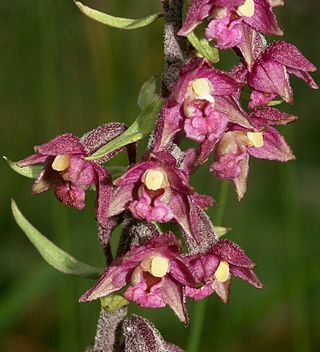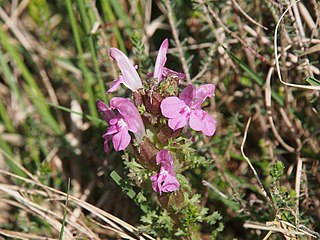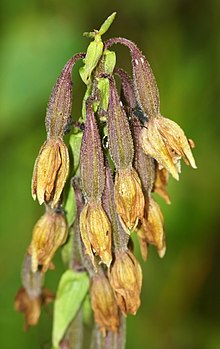
Epipactis, or helleborine, is a genus of terrestrial orchids consisting of approximately 70 species. This genus is abbreviated as Epcts in horticultural trade.

Caltha palustris, known as marsh-marigold and kingcup, is a small to medium sized perennial herbaceous plant of the buttercup family, native to marshes, fens, ditches and wet woodland in temperate regions of the Northern Hemisphere. It flowers between April and August, dependent on altitude and latitude, but occasional flowers may occur at other times.

Cephalanthera rubra, known as red helleborine, is an orchid found in Europe, North Africa and southwest Asia. Although reasonably common in parts of its range, this Cephalanthera has always been one of the rarest orchids in Britain.

Cephalanthera longifolia, the narrow-leaved helleborine, sword-leaved helleborine or long-leaved helleborine, is a rhizomatous herbaceous perennial plant in the family Orchidaceae. It is native to light woodland, and widespread across Europe, Asia and North Africa from Ireland and Morocco to China. This includes the United Kingdom, Iran, Russia, Kazakhstan, Turkey, Algeria, India, Pakistan, Germany, Italy, France, Spain, Portugal and many other countries.

Neotinea ustulata, the burnt orchid or burnt-tip orchid, is a European terrestrial orchid native to mountains in central and southern Europe, growing at up to 2,400 m (7,900 ft) elevation. The plant is considered Endangered in Great Britain and Least Concern internationally based on IUCN Red List criteria. The burnt-tip orchid was voted the county flower of Wiltshire in 2002 following a poll by the wild flora conservation charity Plantlife.

Epipactis atrorubens, the dark-red helleborine or royal helleborine, is an herbaceous plant in the orchid family, Orchidaceae.

Epipactis helleborine, the broad-leaved helleborine, is a terrestrial species of orchid with a broad distribution. It is a long lived herb which varies morphologically with ability to self-pollinate.
Epipactis helleborine var. youngiana, known as Young's helleborine, is a variety of orchid that is endemic to Great Britain. It has also been treated as a separate species, Epipactis youngiana.

Dendrobium kingianum, commonly known as the pink rock orchid, is a flowering plant in the orchid family Orchidaceae and is endemic to eastern Australia. It usually grows on rocks, rarely as an epiphyte, and has thin, spreading leaves and spikes of up to fifteen, usually pink flowers in late winter to spring. It is popular in Australian native horticulture and is a commonly cultivated orchid among Australian orchid species growers.

Epipactis gigantea is a species of orchid known as the stream orchid, giant helleborine, and chatterbox. This wildflower is native to western North America from British Columbia to central Mexico. This is one of the most abundant orchids of the Pacific coast of North America.

Lathyrus palustris is a species of wild pea known by the common name marsh pea. It is native to Europe, Asia, and North America. It is a perennial herb with leaves made up of oval-shaped or oblong leaflets a few centimeters long. It has branched, coiled tendrils. The plant bears an inflorescence of two to eight pinkish purple pea flowers each up to two centimeters wide. The fruit is a dehiscent legume pod.

Dracula vampira is an epiphytic orchid species, endemic to Ecuador.

Cephalanthera damasonium, the white helleborine, is a species of orchid. It is widespread across much of Europe, the Middle East and Asia. Cephalanthera damasonium is the type species of the genus Cephalanthera.

Epidendrum calanthum is a terrestrial reed-stemmed Epidendrum orchid from the montane Tropical rainforest of Bolivia, Colombia, Ecuador, Peru, Venezuela, and the West Indies.

Epipactis dunensis, commonly known as dune helleborine, is a species of plant in the orchid family Orchidaceae and is endemic to Great Britain and Ireland. It typically grows to a height of 20–50 cm (7.9–19.7 in) and the upper half of the flowering stalk is hairy. The plant has a long, fleshy rootstock and three to ten yellowish green, oval to lance-shaped leaves arranged in opposite rows along the flowering stem with up to 35 flowers. The three sepals are greenish, the two petals paler, the lower part of the labellum is boat-shaped and dark, chocolate brown with a transparent, whitish rim and the epichile is heart-shaped with a pointed tip. Flowering occurs from late June to mid-August, the flowers are mainly self-pollinated, and the fruit is a capsule, from which light, microscopic seeds are spread by the wind.

Helleborus viridis, commonly called green hellebore, is a species of flowering plant in the buttercup family Ranunculaceae, native to Central and Western Europe, including southern England. All parts of the plant are poisonous.
Caltha scaposa is a low, perennial herb with one or two yellow hermaphrodite saucer-shaped flowers. This marsh-marigold species belongs to the buttercup family, grows in moist alpine fields and is native to the eastern Himalayas and the mountains on the eastern margin of the Tibetan highland.

Pedicularis sylvatica, commonly known as common lousewort, is a plant species in the genus Pedicularis. It is native to central and northern Europe where it grows on moist acidic soils, moorland, grassy heathland and the drier parts of marshes.
Hatherton Flush is a Site of Special Scientific Interest (SSSI) by the River Weaver in Hatherton, near Wybunbury, Cheshire, England. It is protected for its variety of wetland plants. Species found at the site include the locally rare plants marsh helleborine, marsh lousewort and tubular water dropwort. Hatherton Flush is the largest example of this kind of flush in the county. The site was assessed as being in an "unfavourable"/"recovering" condition in 2008.























